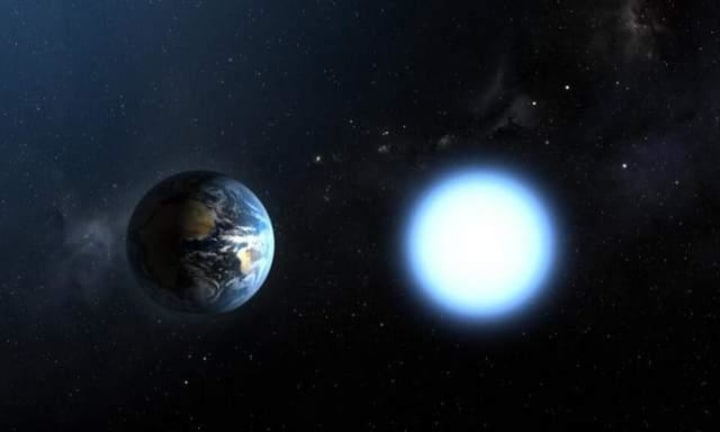Beneath the light of Sirius lies a dangerous celestial body
"Supernova explosion"

Sirius is the brightest star in the night sky, and its great name is also known to us, but perhaps you do not know that under the light of Sirius, there is a dangerous celestial body hidden, which may threaten the Earth in the future, let's take a look at the specific situation.
In the evolution of many stars in the universe, a high-energy event called a "supernova explosion" may occur, in a very short period, the energy released can be comparable to the total energy released by the sun in its lifetime, and its brightness can usually illuminate the entire galaxy where it is located so that hundreds of millions of light years away, we can observe. We can observe it from hundreds of millions of light-years away.
According to astronomers' estimates, if a supernova explosion occurs within 50 light-years from Earth, it will seriously threaten the ecological environment on Earth, and if this range is reduced to 30 light-years, the radiation energy and high-energy particles released by the supernova explosion will destroy the ecological environment on Earth, and the Earth will become a dead planet.
As the brightest star in the night sky, the distance between Sirius and Earth is only about 8.6 light years, so it is not difficult for us to imagine that if a supernova explosion occurs during the future evolution of Sirius, then the many lives on Earth, including us humans, will meet a sad end. So the question arises, will Sirius undergo a supernova explosion?
Sirius is a binary star system, the star visible to our naked eye is called "Sirius A", a blue dwarf star in the main sequence stage, its radius is about 1.711 times that of the Sun, and its mass is about 2.063 times that of the Sun.
According to astronomers' estimation, only main sequence stars with a mass of more than 8 times the mass of the Sun can spontaneously explode after their main sequence phase.
Sirius A is far from this condition, and in addition, there is not enough matter in the space around it to increase its mass significantly, so we do not have to worry about this star.
But beneath the light of Sirius lies a dangerous object, which is the companion of Sirius A - Sirius B. The reason why it is dangerous is that it may threaten the Earth in the future. Astronomers speculate that this object will evolve together with Sirius A in the future, and has a certain probability of supernova explosion.
"Sirius B is a faint white dwarf, which is not visible without professional observation equipment.
A white dwarf is a dense core left after the death of the main sequence star, its internal nuclear fusion reaction has long stopped, and the material constituting this object is mainly carbon and oxygen, they only rely on the "electron abbreviation pressure" to counteract the gravitational collapse of the object itself, so the density of white dwarf is quite high, how high is it? Let's say that if the Sun had the same density as a white dwarf, it would be about the same size as the Earth.
If a white dwarf exists in isolation, it is safe, but if a white dwarf has the opportunity to absorb extra mass from cosmic space, it is dangerous.

Theoretically, the upper mass limit of a white dwarf is about 1.44 times the mass of the Sun, which is also known as the "Chandrasekhar limit", and once this limit is exceeded, the "electron abbreviation pressure" cannot compete with the gravitational force of the white dwarf. In this case, the temperature of the white dwarf will rise rapidly, and when the temperature of a certain region reaches a certain level, carbon and oxygen will undergo nuclear fusion.
As the fusion of carbon and oxygen in a region of the white dwarf is "ignited", the heat will be transferred rapidly throughout the star, leading to the fusion of more and more carbon and oxygen, which will cause the temperature of the whole planet to rise sharply, and the fusion is extremely sensitive to temperature. The reaction rate will increase exponentially as the temperature rises ......
As you can see, this is a positive feedback process, as this process continues, the white dwarf will occur in a very periodontist control thermonuclear explosion, and this phenomenon is a kind of supernova explosion, astronomers call it "type Ia supernova".
Observations show that Sirius B is about 1.1 times as massive as the Sun, which means that it only needs about 0.34 times more solar mass to go supernova, so where might it get the extra mass? The answer is "Sirius A".
As things stand now, Sirius A is a stable main sequence star, and its gravity is firmly bound to its matter, so Sirius B can't GE matter from Sirius A. It is impossible for "Sirius B" to obtain matter from "Sirius A".
But all stars in the universe have a "fuel exhaustion" day, and Sirius A is certainly no exception. According to the known laws of stellar evolution, this star will evolve into a massive red giant after the main sequence stage.
Compared to main sequence stars, red giants are much less bound to their matter, and on top of this, there are occasional "helium flashes" in their cores, resulting in a significant loss of matter from the red giant.
"The average distance between Sirius B and Sirius A is about 20 astronomical units, which is about the distance between Uranus and the Sun, and at this distance, if Sirius A "At this distance, if Sirius A evolves into the red giant stage, Sirius B will be able to absorb a lot of material lost from this red giant.
For intermediate-mass stars like Sirius A, about 70% of their total mass is lost during their red giant phase, which is about 1.44 times the mass of the Sun, which means that Sirius B only needs to absorb This is about 1.44 times the mass of the Sun, which means that Sirius B only needs to absorb a quarter of this material before a supernova explosion will occur.
Observations show that the average distance between Sirius B and Sirius A is about 20 astronomical units, which is about the distance between Uranus and the Sun, and in this case, Sirius B "In this case, it is possible for Sirius B to absorb enough material for a supernova explosion to occur, which is why we say it is a dangerous object that could threaten the Earth in the future.
It is important to note that this can only be said to be a possible scenario for this binary star system in its future evolution, not that it will necessarily happen.
According to astronomers' estimation, the main sequence star stage of Sirius A is about 1 billion years old, but now it is only about 240 million years old, which means that even if a supernova explosion will occur in Sirius B in the future, it will be 760 million years away. If there are still human beings on Earth at that time, their technology should be able to deal with this threat easily after such a long time of development.
Well, that's all for today, welcome to follow us and we'll see you next CHM .
About the Creator
Carlo Phil
Science and art are two sides of a coin






Comments
There are no comments for this story
Be the first to respond and start the conversation.